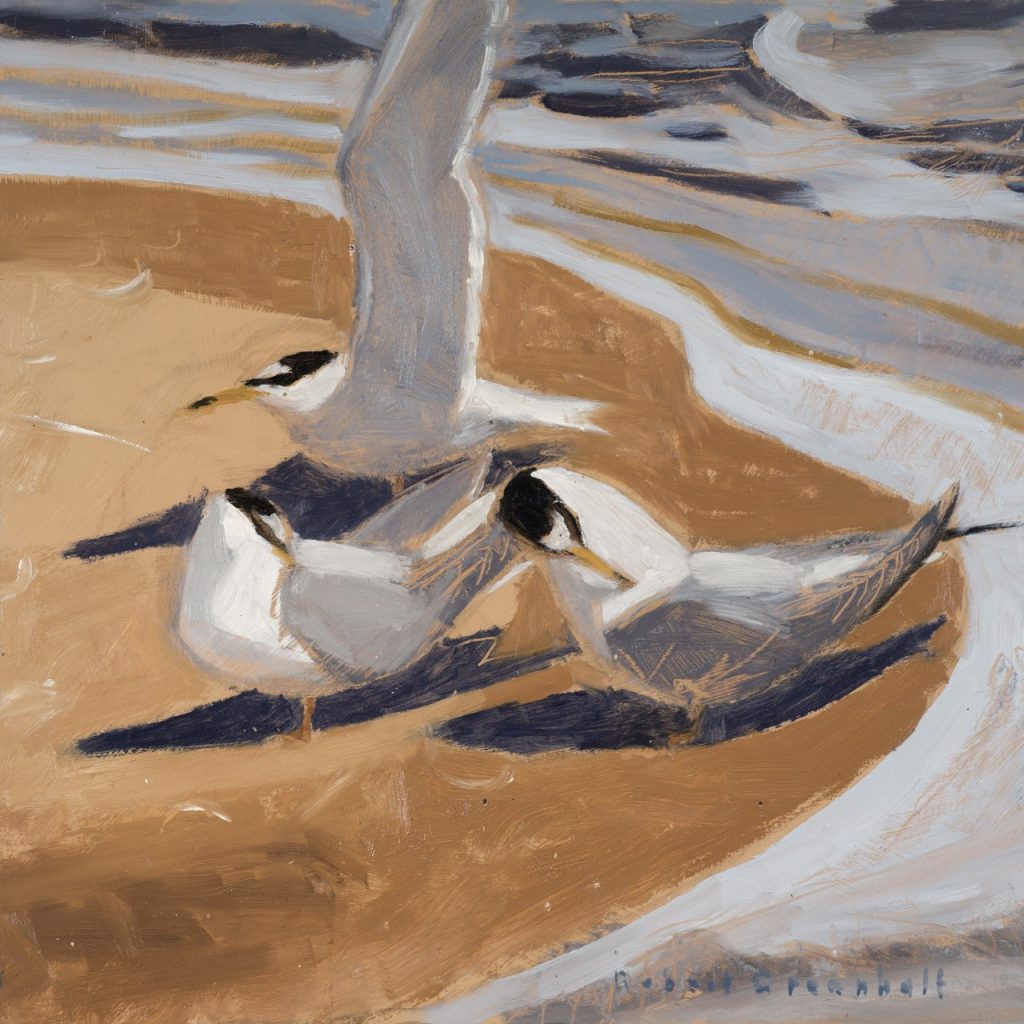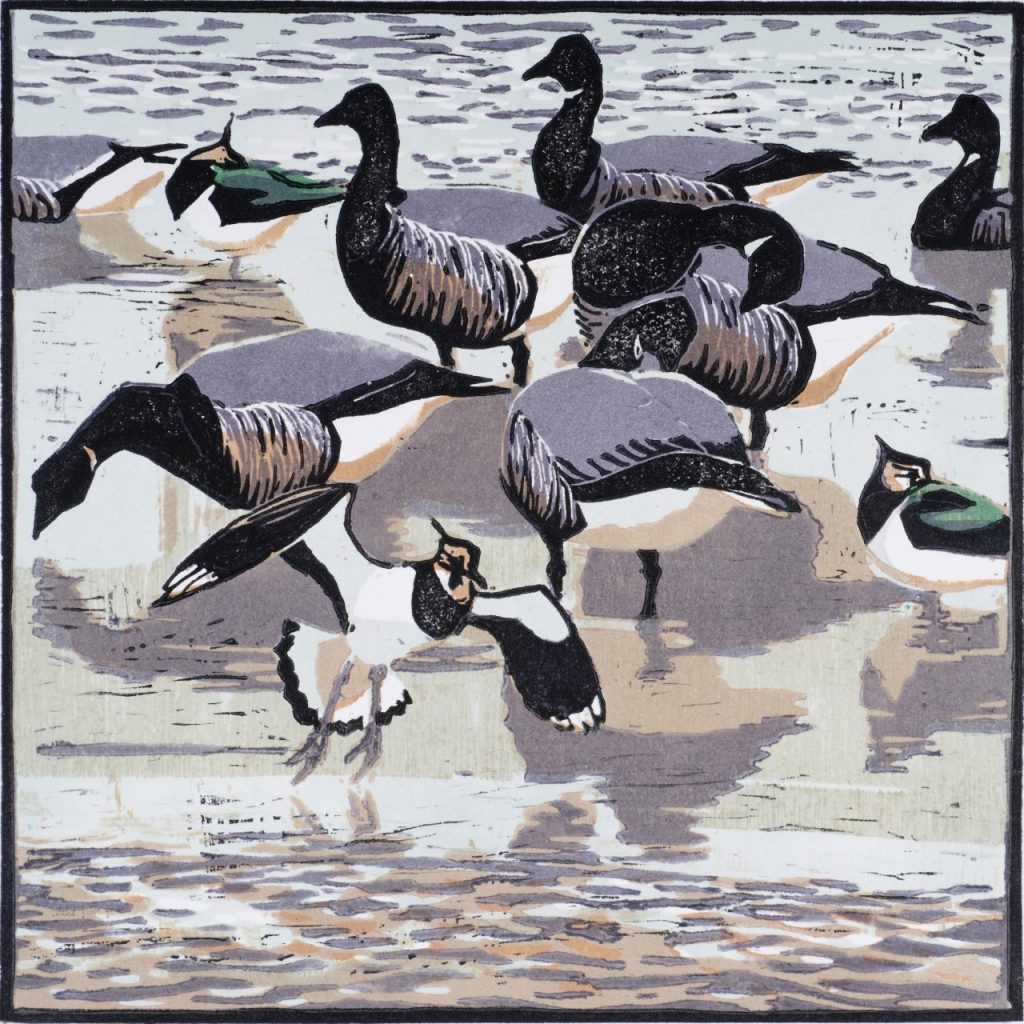Wildlife artist Bob Greenhalf has long been associated with Rye Harbour Nature Reserve. Emma Chaplin talks to him:
Tell us a bit about yourself and your relationship with Rye Harbour Nature Reserve
I live just outside Rye, about three miles from Rye Harbour Nature Reserve, with my wife, Sally.
I was brought up on the edge of Haywards Heath, surrounded by woods and fields, where my sister, brother, friends and I spent our spare time. As a result, we all grew up with a love of wildlife which has remained with us since. We joined various junior sections of the wildlife organisations that sprang up in the sixties, which took us to new, exciting areas to watch birds.
My love of drawing and painting, particularly landscape and wildlife, was also growing. I left school at sixteen to begin five years at Art College, first at Eastbourne, then Maidstone, where I spent a lot of time in the printmaking department. I was greatly encouraged in this by one of my tutors, the printmaker Graham Clarke, who employed me in his studio and encouraged me to do my own prints, suggesting galleries where I might sell them.
At this time, I started visiting Rye Harbour and became good friends with the then warden Kelvin Cawte. I often stayed at Watch Cottage and helped out with the wardening on a voluntary basis. Over forty years later, the reserve is still a place that I visit for inspiration and work, and of course, it gets better all the time.

Describe your artistic process
All my paintings and prints begin in the field, where perhaps a group of birds or an effect of the light will attract my attention and I will then make rapid pencil sketches and maybe apply some watercolour or colour notes to try to capture the moment in my memory. Back in my studio I may make a quick watercolour or oil painting, using the field sketches as reference.
Alternately, I may decide that it will make a good subject for a woodcut. I then work out the composition on layout paper and transfer it to the wood blocks using carbon paper. Each colour requires a separate block, most woodcuts employ five or six. Each has to be worked on in turn, cutting away with gouges the parts that I don’t want to print in that colour, until all the blocks have been cut and it’s time to take a proof. Each block has a different coloured ink applied to the surface with a roller and they are then put through the press to form the print.

What’s your favourite bit of kit?
Probably my Swarovski binoculars – I feel naked without them on a walk!
Where do you work?
Firstly, in the field, but then in my studio, a large shed in my garden.
What do you enjoy most about being an artist?
Freedom to work when and where I choose to and the opportunity to visit many wild and beautiful areas of the world, often with fellow artists.
And the downsides?
A totally unpredictable income and the necessity to sometimes work outdoors in extremes of heat or cold.

How did you feel after your recent ‘hard hat tour’ of the Rye Harbour Discovery Centre?
I felt hugely impressed and inspired, it will be a much needed and fitting addition to the reserve.
What are you looking forward to most?
Sitting behind that huge picture window in the warmth with a cup of tea in hand, looking out across our wonderful reserve.
Tell us about the Love a Plover frieze.
Alan Martin came up with the excellent idea that everyone who donated over £500 to the Discovery Centre Appeal would have a Golden Plover dedicated to them, to form part of a frieze of Plovers which would be displayed to visitors to the building. Large flocks of Golden Plovers are a feature of the reserve in winter and should be visible from the centre windows.

My part so far has just been to draw the plover shapes and produce an artist’s impression of how the final display might look on the wall.Thanks to the generosity of so many people, we are now over 110.
The Plovers are flight silhouettes cut out of two different coloured ply woods; cherry which is a warm golden colour to represent the top side of the birds and another much paler one for the undersides. They will be assembled in the shape of a moving flock on a dark grey background to symbolise a stormy sky.
Next to the Golden Plover frieze will be a plaque, naming all of those who have been generous enough to support the project via the Buy a Bird scheme. If you want to support the Discovery Centre Appeal, see here
You can buy Bob’s ‘Oystercatchers, Rye Harbour’ print as a linocut unframed from the Info Cabin, as well as in Christmas card form, and the print from the Avocet Gallery (£185 framed, £115 unframed – half the retail price goes to the Discovery Centre Appeal).

Image Credits: Sussex Wildlife Trust .



